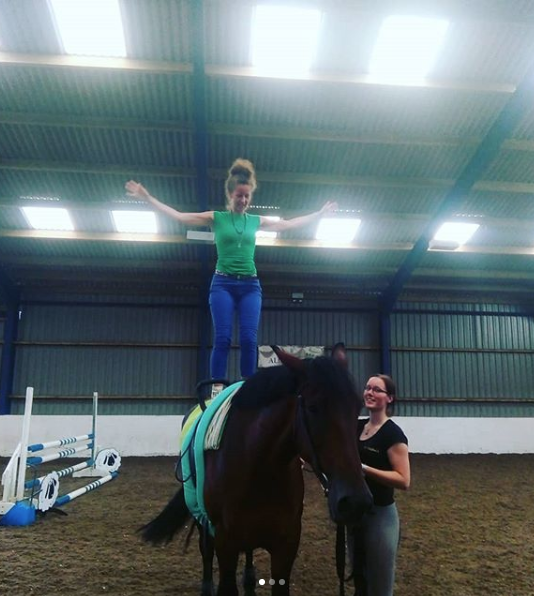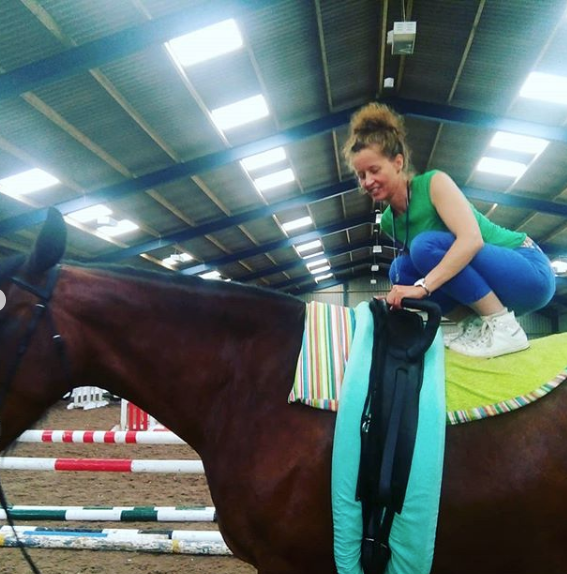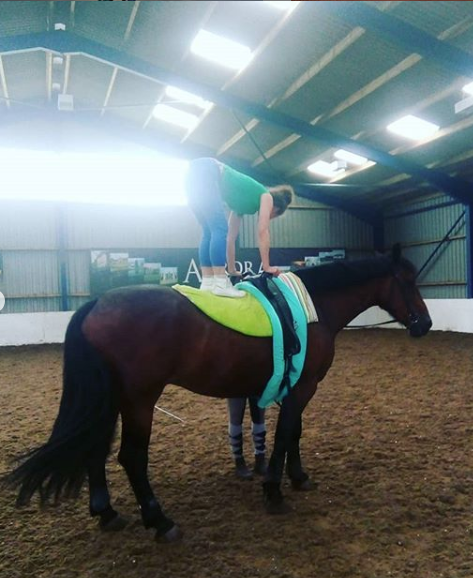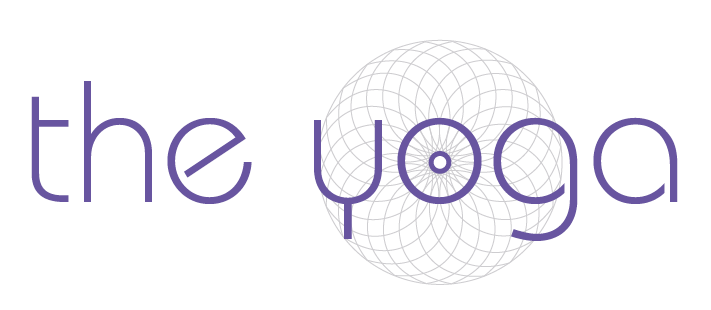


The other week I found myself doing yoga on a horse. Yes. Me standing on a horse on a Saturday afternoon! How did that happen? Obviously I love yoga, and do a fair amount every week, but on a horse with the gymnastic vaulters? I used to horse ride as a kid, loved it, but in adulthood, it just hasn’t worked out. Maybe I have not met the right horse! I visited an in-laws horse with eager anticipation, to meet the most arrogant and aggressive horse in my life. The wild rangy power of this horse and maybe more significantly the relationship to the owner really shook me. I’d never disliked or wanted to get away from a horse in my life. But there it was. I went to a riding stable but the poor souls were just beasts of burden. I gave up.
Then the local vaulting team asked me to get involved to help them develop their vaulting through yoga. I was of course very curious – what is vaulting? Why do they want my help? At first, I was excited and then rapidly became concerned about the horses and whether I would be able to be involved. How the horses experience it? And the vaulters? How do they treat their animals? Maybe they would be whipped? Downtrodden? Enslaved?
What is vaulting?
Vaulting is a highly competitive sport where people do creative gymnastic sequences on a moving horse. The horse is on a leash and canters at a steady pace. The vaulters perform a sequence of dance like gymnastics to music and attain points for their skill, poses shown, interpretation and creativity.
So why do they want a yoga teacher?
They are stronger than I am, more flexible than I am and they know horses better too. They want a yoga teacher to bring a new angle to their practice. There are basic commonalities: strength and flexibility. There are some other things that are personal yoga loves of mine – the way I practice yoga is freer and more soft than many. With vaulting this is extremely important. To stand on a moving horse you can’t be hard, tight and rigid, you have to have fluidity. If you do an Ashtanga triangle you’ll be off in a second. It’s just too rigid. You need softness in the knees and hips to meet the movement of a cantering horse beneath your feet. You need flexibility, but the flexibility needs to be changeable, highly dynamic – not just stick person up, down, left, right – it needs to be 360 degrees of awareness and possible aliveness.
And how did you end up doing yoga on a horse’s back?
So back to my worry about the horses. This was my non-negotiable. The horses certainly work but I needn’t have worried. I met their stud, healing after an injury. A soul with deep warm eyes, some pain, but such a loving horse. Then I went to the training ground to see the practice session. The kids were on task, running in step with the horses, jumping on, showing their routines. I loved watching their spines move, the rhythm, the interaction. I watched a beautiful limber vaulter jump, slide and twirl over her horses back.
And then they asked if I’d like a go. My sensible me would say ‘maybe next time’, but sensible me was not to be seen, so ‘yes’ it was. I was nervy, wondering how the horse would react to me, what would he feel? We, the horse and I, had a chat before I got up. He was such a steady, rock-solid dependable boy, and so tender, I fell in love immediately. I got up and of course found myself way higher up than I’d imagined and vertigo threatened to set in, but I found my feet and I began to trust him. All fours, tadasana, forward bend, squat. The most phenomenal was tadasana, because as he walked his pelvis rocked profoundly. Under me wasn’t on a sticky mat, not the floor, not undulating sand, not even a flightly surfboard but a glorious stallion. One who is alive, moving, breathing, who although utterly reliable is ‘human’ just like me. He might stumble, start. It could go wrong. It didn’t. I felt such gratitude to him, for supporting me. I loved his movement, and my movement, and the way we had to work together. At one point I startled and caused him to startle too – just an ear prick, but in that proximity, we shared each other’s experience. We had to work together and trust was vital. I could hurt him if I slipped or fell, he could hurt me if he was unpredictable.
Of course, you can reread the above paragraph and apply it to other relationships, how we are with others, when and how we blindside them, shock them, how we react when someone else does the same and ultimately how we choose to be with others, how far can we go. But let’s come back to traditional yoga.
How can we learn to trust our bodies?
When you start to do yoga you can hear so many stories, or such stories of pain and inflexibility that it can make you want to run away. People sometimes come to class and feel so much remorse for what their body is now compared to what it was and could do. Other days it’s an injury that is overwhelming their experience, and sometimes it’s the anxiety of living. A pose can turn into a stream of self-deprecating thoughts. We meet our stuff when we come to yoga. We meet it, and in time we learn to meet it kindly. We learn to trust that our bodies have a wisdom and that if we listen kindly we can get on really well together.
Mind, body and spirit
In the Bhagavad Gita there is an analogy. A god directing a chariot. The horses are the senses, what we observe, the reins is the mind, the charioteer as the intellect. The horses can distract, the reins try to control, the charioteer sometimes off course. I’ve decided to make my analogy simpler.
Often people have a separation between their mind and body. Their mind decides what they want to do, can do and their body is told to complete the action. The body can be treated like a slave – ‘Just do it. Just do it or I will resent you and punish you’. This is normal, and insidious if left unchecked. We age, time passes and things we could blast through are no longer possible. The increasing circles start to decrease and with it, a sense of loss can occur. I took one woman into a headstand at a workshop. She was terribly nervous as shed not done one in 20 years. Afterwards she was crying happily, as she had re-found a part of herself that she thought was gone. She found her mental constrictions and went beyond them. She learned that she could trust her body to be more than she had imagined, safely.
If you hear yourself castigating your body or you know this pattern in yourself try to think of your body a horse, a stunning, strong and beautiful horse. I can hear your thoughts, about your body is going to be an old gnarly nag, or a broken dilapidated one. A workhorse ready for the dump and other over-dramatic stories. Nope. See your body as a wonderful healthy horse, but one who you must work rather carefully with. As much as you trust them they are separate from you and need a massive amount of respect, care and observing. Watch the horse’s shoulder shudder, the flick of his tail, the twitch of his ear, the slight movement of his head. When doing pigeon pose listen to your knee joint, the inside of your hip joint, the spine and sensations of energy, feel your breath, notice its flow. Listen really carefully. Not like you’re sitting on a horse, strapped in, saddled, helmet on, horse on a leash. Listen like your standing on a horse bareback, no helmet, no safety net What is happening behind your eyes? To their focus? How is your mind moving now? Now? And this moment? Listen so carefully.
If you and your body are very much in unison and you find the above paragraph confusing: celebrate it. You still need to listen, but maybe the attention to what is happening in your body has become easier. If so, start to notice just beyond your body, the energy space around you. If you practice with too much intention what happens to your energy field? If you lose focus what happens to the space around you?
In summary
When you practice yoga or hop onto a horse, listen and listen well. Open out to what is possible whilst coming back to being safe: mind, body, and spirit. Every moment is precious and every moment offers the possibility for transformation. So that is how I ended up doing yoga on the back of a horse. Doing yoga on horseback was some of the most exhilarating yoga I’ve done in my life. I can’t wait to go back! But until I do, I will listen carefully and focus on this moment, now this moment, now this moment.

canHPOqyL
cVHEjwFQlqM
CANBeGEVTv
LXSnvyrpVaukG
FAERNKYTBDcQj
Obecnie technologia pozycjonowania jest szeroko stosowana. Wiele samochodów i telefonów komórkowych ma funkcje pozycjonowania, a także wiele aplikacji do pozycjonowania. Gdy zgubisz telefon, możesz użyć takich narzędzi do szybkiego zainicjowania żądań śledzenia lokalizacji. Zrozumieć, jak zlokalizować telefon, jak zlokalizować telefon po jego zgubieniu?
Dopóki istnieje sieć, zdalne nagrywanie w czasie rzeczywistym może odbywać się bez specjalnego instalowania sprzętu.